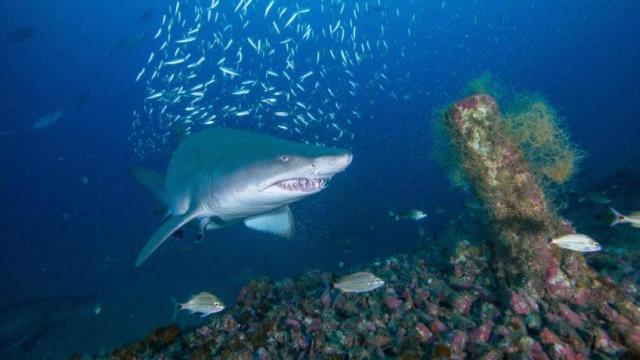Photographs taken by citizen scientist scuba divers show that female sand tiger sharks develop an affinity to certain shipwrecks off the coast of North Carolina — a finding that could prove useful to conservation efforts.
Female sand tiger sharks are returning to same shipwrecks off the North Carolina Coast, according to a new study published in Ecology. This “Graveyard of the Atlantic,” as this coastal region is known, hosts hundreds of wrecks, providing an under-appreciated habitat for these highly migratory apex predators.
Scientists already knew that sand tiger sharks like to frequent these sunken wrecks, but it wasn’t known if the same individuals returned to the wrecks over time. Turns out they do. Scientists call this “site fidelity,” a behaviour in which animals return to specific areas over time. Other sharks are known to do this, including white sharks and tiger sharks.
“Our finding reveals that shipwrecks are potentially critical habitat for sand tiger sharks,” Avery Paxton, the lead author of the new study and a marine biologist at Duke University, wrote in an email to Earther.
“We do not know the exact reason that female sand tigers are returning to the same shipwrecks over time, but our multi-institutional team is conducting additional research to hopefully solve this puzzle.”
With the knowledge that female sand tiger sharks exhibit site fidelity for shipwrecks, Paxton and her colleagues have found a new way to track the population of these sharks, which are listed as globally vulnerable by the International Union for Conservation of Nature (IUCN).
As the new paper pointed out, the “protection of these revisited areas of habitat may facilitate conservation success.”
Scientists can’t possibly monitor each location visited by these sharks, but that’s where citizen scientists can help. North Carolina Aquariums, which is operated by by the Aquariums Division of the North Carolina Department of Natural and Cultural Resources, is currently running a citizen-science program called Spot A Shark USA, which, as its website states, seeks contributions from anyone who swims among sand tiger sharks — a docile species (phew!) — along the Atlantic coast:
Divers, snorkelers, and others are asked to photograph encounters with sand tiger sharks and post their images to the Spot A Shark USA website. Scientists then use unique spot patterns visible along the sides of the photographed sharks to identify individual animals. Identifying individual sand tiger sharks helps track shark movement and behaviour over time. It also determines which coastal habitats sand tiger sharks use during their lives. This information is used by Spot A Shark USA researchers, as well as international partners, to facilitate management decisions aimed towards conserving sand tiger sharks, which are critically endangered in several parts of the world.
Indeed, the unique brown spots on the sand tiger sharks’ skin proved critical to this research. These spots act as a sort of fingerprint that allows research to identify and track specific individuals. In the new study, Paxton and her colleagues identified sharks dating back to 2007, namely six female sharks that returned to the same wreck, or similar wrecks nearby, at intervals between one and 72 months.
In September 2016, for example, a scuba diver photographed an individual female lurking around the shipwreck Aeolus at a depth of 35 meters. Ten months later, the same diver returned to the Aeolus and captured another shark photo. After these images were uploaded to Spot A Shark, a software program compared the markings, identifying the shark as being the same individual.
The new study is the first to document site fidelity in waters along the East Coast, mirroring observations made in Australia, Africa, and elsewhere. That said, the behaviour was only observed in female sand tiger sharks.
“We do not yet have photos of male sand tiger sharks that reveal site fidelity, so we do not know whether male sharks share the site fidelity behaviour to North Carolina shipwrecks,” said Paxton. “As more citizen scientists participate in the Spot A Shark USA program, we hope to be able to answer questions like this in the future.”
Hap Fatzinger, the director of North Carolina Aquarium, is now hoping to learn if the sand tiger shark population is rebounding.
“Through collaborations with researchers along the east coast of the United States we will continue to gather data which supports this question,” wrote Fatzinger in an email to Earther. “We anticipate Spot A Shark USA will document populations of sand tiger sharks and determine trends in habitat use, breeding and potentially birthing occurrences around shipwrecks off North Carolina, all factors that can contribute to a population assessment.”
The North Carolina Aquariums, along with its partners, are working together to make sure future populations of sand tiger sharks are “healthy and sustainable,” he said. Fatzinger described recreational divers as “a critical link” in the quest to better understand these dynamic and fragile ecosystems.
“We are launching a public awareness campaign to engage more divers, connect them to the species, and educate them on behalf of the oceans,” said Fatzinger. “We have only scratched the surface on learning about these sharks off the East Coast and look forward to more work supporting the management and recovery of critically endangered populations of sand tiger sharks in other areas of the world.”
